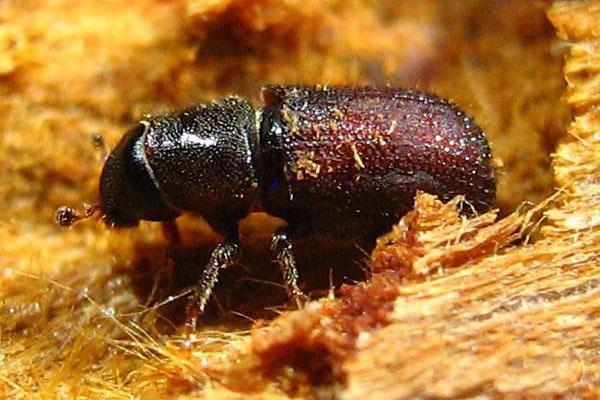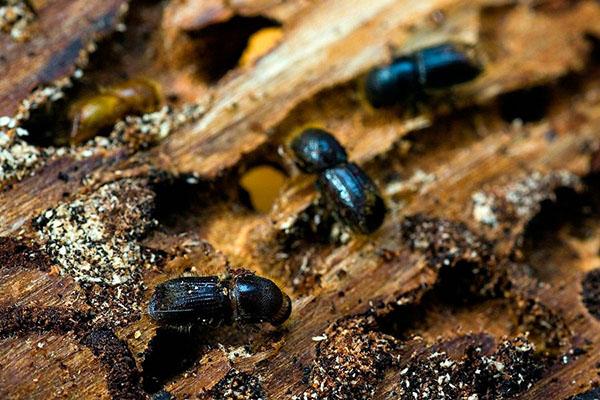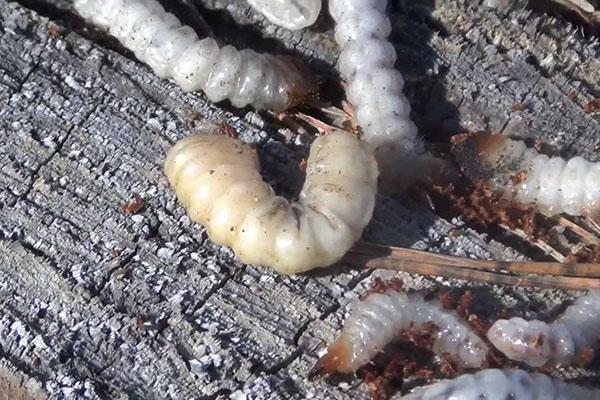The benefits and harms of the bark beetle in the garden at their summer cottage
 The benefits and harms of the bark beetle include all the damage that this insect can do to trees and wood. Despite its small size, an adult is able to gnaw through material and create numerous passages. In nature, there are a huge number of varieties of this pest, and some of them parasitize on cultivated plants, fruit trees, and even in furniture and building materials made from wood. It is useful not only to know how to deal with the bark beetle in the garden and at home, but to carry out preventive measures in time to avoid its appearance and reproduction.
The benefits and harms of the bark beetle include all the damage that this insect can do to trees and wood. Despite its small size, an adult is able to gnaw through material and create numerous passages. In nature, there are a huge number of varieties of this pest, and some of them parasitize on cultivated plants, fruit trees, and even in furniture and building materials made from wood. It is useful not only to know how to deal with the bark beetle in the garden and at home, but to carry out preventive measures in time to avoid its appearance and reproduction.
Description and varieties of bark beetles

Varieties of bark beetle
Most often, the benefits and harms of the bark beetle affect fruit trees.
At home and in the garden, you can find several main types that differ in color and size:
- Domestic bark beetle is the largest, it can grow up to 1.5 cm. In fruit trees it forms large passages, completely destroying them from the inside. Its full life cycle is 10 years, so it is rarely detected at the initial stages of infection.
- Furniture bark beetle is a small pest, up to 3 mm in length. The life cycle of this beetle is no more than 3 years. The parasite can exist at home, gnawing through furniture and wood.
- Powdered bark beetle is a specific pest that turns wood into powder. More often he lives at the points of logging and timber processing, since more often it parasitizes on a fresh tree.
The main substance on which the bark beetle eats is wood of different types, ages and conditions. In nature, the beetle is considered a forest orderly, since it utilizes damaged trees and accelerates the processes of nitrogen metabolism.
Pest life cycle
 Most beetles develop in the same life cycle, but the duration will differ for different species. First, the female lays eggs in cracks in the bark, which then turn into larvae. They develop for several years under the bark, feeding on wood and gnawing through passages.
Most beetles develop in the same life cycle, but the duration will differ for different species. First, the female lays eggs in cracks in the bark, which then turn into larvae. They develop for several years under the bark, feeding on wood and gnawing through passages.
The main factor in which the bark beetle is dangerous is that tree damage occurs imperceptibly, since the larvae do not come to the surface for several years.
They then move to the surface and transform into winged beetles through the pupa stage. When the beetles are ready to mate, their developmental cycle repeats.
The benefits and harms of the bark beetle at home and in the garden
 For different types of trees and wood there is a bark beetle. These pests completely destroy the inside of the trunk, keeping the bark intact. When they are populated in large numbers, it is impossible to get rid of them, since they are located deep in the trunk.The only positive feature is that bark beetles often populate specimens that are already old or affected by other pests, which are already weakened due to age or diseases.
For different types of trees and wood there is a bark beetle. These pests completely destroy the inside of the trunk, keeping the bark intact. When they are populated in large numbers, it is impossible to get rid of them, since they are located deep in the trunk.The only positive feature is that bark beetles often populate specimens that are already old or affected by other pests, which are already weakened due to age or diseases.
In order to start fighting a pest on time, it is important to recognize it at the first stages:
- the first sign is the appearance of a large number of woodpeckers;
- falling leaves, deterioration of the general appearance of the plant and its condition;
- the appearance of small holes in the bark;
- the appearance of dust that spills out is a sign of a strong degree of infection;
- peeling of the bark is a symptom of plant death due to pests, even if there are branches with leaves on it.
At home, the bark beetle is not useful. However, the harm to log houses and wooden structures can be compared to a fire - if you do not notice the beetle in time, they cannot be restored.
Pest control measures

The most effective remedies for bark beetles in the garden:
- "Antizhuk";
- "Calypso";
- "Clipper";
- "Senezh Insa" and others.
They contain substances that are detrimental to beetles and larval stages of parasites. Some of them ("Antizhuk") provide additional protection against fungus. The drugs are poured into the holes in the bark using a syringe. The procedure is repeated several times, and then the bark beetle passages are closed with an ordinary garden pitch. All treatments are carried out in a protective suit, gloves and a respirator.
Preventive actions
 Knowing how to deal with the bark beetle on fruit trees is not enough. There are simple and effective preventive measures to avoid these pests.
Knowing how to deal with the bark beetle on fruit trees is not enough. There are simple and effective preventive measures to avoid these pests.
These include:
- pruning dry and damaged branches in the garden;
- processing of the lower part of the bark with lime;
- add crushed laundry soap to preparations for tree processing - this will allow them to better stay on the bark;
- laying out traps for bark beetles for the summer (ordinary blocks of fresh wood) - the method is not effective enough, since different types of beetles may prefer trees of different varieties and ages;
- additional processing of the trunk and large branches with folk remedies (clay mixed with humus or lime with manure).
If characteristic holes appear on the bark of a tree, this indicates a high degree of infection. In some cases, all the ways how to deal with bark beetle larvae may already be ineffective.
The balance of benefits and harms from the bark beetle clearly outweighs in the direction of the harmful effect. These parasites can completely destroy fruit trees and even building structures. Regular preventive treatments are more effective, since beetles can remain in wood for a long time unnoticed.